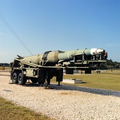Current displays
Redstone Arsenal
Redstone Arsenal, Alabama played an important role in the development, fielding and management of Pershing. The United States Army Missile Command managed the system and Ordnance officers, warrant officers and enlisted technicians were trained at the United States Army Ordnance Missile and Munitions Center and School.
A Pershing 1 missile was originally located in front of Newhall Hall near Gate 10 until 2010. [2] It is now located at Pershing Park on Honest John Road and is mounted on a pedestal. The plaque with a launch photo originally had a photo of a PGM-11 Redstone launch; this has been corrected but the date of 1977 should be 1982. A Pershing 1a and a Pershing II that were once on display at the U.S. Space & Rocket Center are in storage on the arsenal in warehouse building 8021. [3]
- Pershing 1
- Dedication plaque
- Description plaque
Pueblo Chemical Depot
Major repairs on Pershing components were performed at Pueblo Depot Activity (PUDA), Colorado. Motor and other testing for Pershing II took place in 1983. A Pershing 1 missile on the M3 erector launcher is in front of the depot headquarters and a Pershing 1 on a fabricated cradle is on display at Hi-PADner Park.
- Pershing 1 at Headquarters
- Pershing 1 at Headquarters
- Pershing 1 at Hi-PADner Park
Pueblo Weisbrod Aircraft Museum
Pueblo Weisbrod Aircraft Museum has a Pershing 1 missile in outside storage with the intent to refurbish it and put it on display.
Cape Canaveral Space Force Station
Test launches of the Pershing were performed at what is now Cape Canaveral Space Force Station, Florida. The Air Force Space and Missile Museum had a Pershing II on an erector launcher in an outside display. [4] The missile and launcher were refurbished in 2020 and placed on display inside Hangar C. [5] The History Center has a Pershing 1 warhead and guidance and control section that was removed from a missile that was on display in the Rocket Garden and damaged in a hurricane.
- Pershing II in an outside location
- Pershing 1
White Sands Missile Range
Test launches of the Pershing were also performed at White Sands Missile Range, New Mexico. The White Sands Missile Range Museum has a Pershing II on an erector launcher and a Pershing 1 in the outdoor display.
- Pershing II
- Pershing 1
Fort Sill
The United States Army Field Artillery School is located at Fort Sill, Oklahoma. The school trained Field Artillery officers and enlisted crewmembers for Pershing. The United States Army Artillery Museum has all three types of Pershing on their launcher.
- Pershing II
- Pershing 1a
- Pershing 1
Fort Gregg-Adams
The United States Army Ordnance Missile and Munitions Center and School at Redstone Arsenal, Alabama was renamed to the United States Army Ordnance Munitions and Electronic Maintenance School in 2002 and moved to Fort Lee, Virginia, now Fort Gregg-Adams, in 2011. The United States Army Ordnance Museum at Aberdeen Proving Ground, Maryland was moved to Fort Gregg-Adams in 2010 and is now the United States Army Ordnance Training and Heritage Center. The OTHC has a Pershing 1 on transporter erector launcher located at Ordnance Circle. The air fins, thrust reversal port covers, cable mast and retaining band are missing and the sign misidentifies the missile as a Pershing II.
- Pershing 1
Virginia Air and Space Science Center
The Virginia Air and Space Science Center, Hampton, Virginia has a Pershing II in an indoor display. [6]
Militärhistorisches Museum Flugplatz Berlin-Gatow
The Militärhistorisches Museum Flugplatz Berlin-Gatow, Germany has a German Air Force Pershing 1a on erector launcher with Magirus-Deutz Jupiter 6x6 truck. The work platform has been removed from the erector launcher and the missile is blocked at a display angle. Beside it is a MAN truck carrying the Programmer Test Station and Power Station.
- German Air Force Pershing 1a
Technik Museum Sinsheim
The Technik Museum Sinsheim, Sinsheim, Germany has an outdoor display of a German Air Force Pershing 1a on erector launcher and a programmer test station and power station on MAN 630L2A truck. [7] A console from the Programmer Test Station is on display inside the museum.
- Pershing 1a
- Pershing 1a Programmer Test Station and Power Station
Central Armed Forces Museum
The Central Armed Forces Museum, Moscow, Russia has a Pershing II in an outdoor display. It was received from the National Air and Space Museum in exchange for a SS-20.
| External image | |
|---|---|
| |
SPEC OPS Plaza
The SPEC OPS Plaza in Jackson, Missouri is located behind the Jackson Medical Center; both are operated by Dr. Charles Pewitt. An early Pershing sits outside awaiting refurbishment.
| External image | |
|---|---|
| |


















